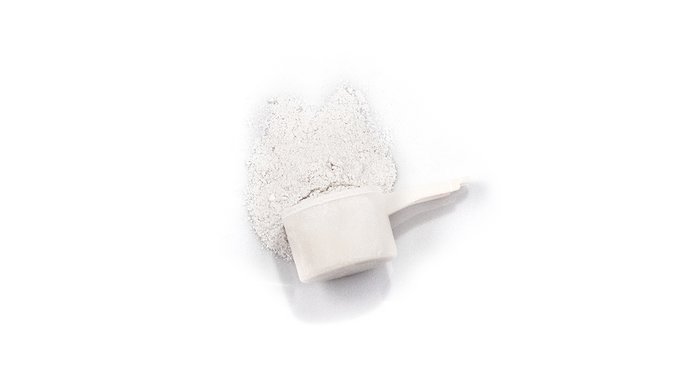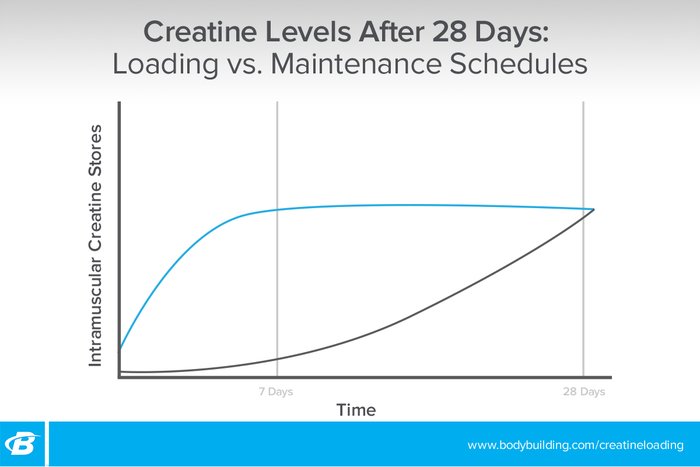Creatine monohydrate is one of the best-researched supplements on the market. Taken consistently, it can serve to enhance the quality of training and volume of work, leading to greater adaptations in strength, power, and lean body mass.[1-3] Surprisingly, debate continues on how to take it. Some experts strongly believe that a loading phase is necessary to maximize gains, while others deem it irrelevant. Let's look at the science.

Approximately 1 gram of creatine is produced by the body per day. A diet high in meat and fish will also provide about a gram of creatine per day. Conversely, creatine is broken down (or degraded) into creatinine at a rate of 2 grams per day.[4] Given that the daily production and consumption of creatine matches it's daily breakdown, supplementation can be a great way to maximize stores.
Clearing Up the Confusion
Whether you load or stick to a low dose, supplementing with creatine can increase your resting levels by 17-20 percent.[5] Your method of taking creatine will ultimately affect how quickly you see that increase.
When we use the term "creatine loading", we're talking about a higher initial dose of creatine for 5-7 days before a lower "maintenance" dose. Typically, this looks like 20 grams divided into four equal doses for a week (5 grams taken four times per day), followed by 3-5 grams per day thereafter.[6] This initial loading phase serves to rapidly increase intramuscular creatine stores, while the maintenance phase ensures that your creatine stores stay saturated.
On the other hand, other studies have examined doses of 3-5 grams without an initial loading phase and found similar increases in creatine stores after 28 days.[5] An initial loading phase may help to increase total creatine stores at a faster rate than a lower dose, but the difference between a loading phase or just a regular dose of 3-5 grams will be negligible after one month.

Another note on loading: Skeletal muscle has a limited capacity to store creatine. It appears that with a loading dose of 20 grams, your muscles reach maximum capacity after about two days. By the third day of a five-day loading period, up to 60 percent more creatine is lost through urine.[4] So if you decide to load, anything after three days may be excessive, although this can vary by individual.
Should I Load?
This is completely up to you, and should be based on your goals. Loading will allow you to reap the benefits of creatine much quicker. If you're a weightlifter, you may consider implementing a loading phase to see faster increases in muscular strength, power, and size. However, after one month, there is no difference in intramuscular creatine stores, whether an initial loading phase is completed or not. Unless you have an upcoming competition, my recommendation would be to take it slow.
For weight-class athletes, avoidance of a loading phase may help ward off a large and less-than-desirable change in body weight as a result of water retention from using a higher dose of creatine. (Conversely, others may get a psychological boost from this initial increase in body weight—even though it's mostly water—because they feel "bigger.") Furthermore, some people complain of GI discomfort during a loading phase, likely due to an increase in water intake and retention, all of which can be avoided by sticking with a low dose.
References
- Chilibeck, P. D., Chrusci-Ll, M. J., Chadi, K., Davison, K. S., & Burke, D. G. (2005). Creatine monohydrate and resistance training increase bone mineral content and density in older men. The Journal, 9(5).
- Tarnopolsky, M. A., & Maclennan, D. P. (2000). Creatine monohydrate supplementation enhances high-intensity exercise performance in males and females. International Journal of Sport Nutrition and Exercise Metabolism, 10(4), 452-463.
- Kutz, M. R., & Gunter, M. J. (2003). Creatine monohydrate supplementation on body weight and percent body fat. The Journal of Strength & Conditioning Research, 17(4), 817-821.
- Persky, A. M., Brazeau, G. A., & Hochhaus, G. (2003). Pharmacokinetics of the dietary supplement creatine. Clinical Pharmacokinetics, 42(6), 557-574.
- Hultman, E., Soderlund, K., Timmons, J. A., Cederblad, G., & Greenhaff, P. L. (1996). Muscle creatine loading in men. Journal of Applied Physiology, 81(1), 232-237.
- Buford, T. W., Kreider, R. B., Stout, J. R., Greenwood, M., Campbell, B., Spano, M., ... & Antonio, J. (2007). International Society of Sports Nutrition position stand: creatine supplementation and exercise. Journal of the International Society of Sports Nutrition, 4(1), 6.

